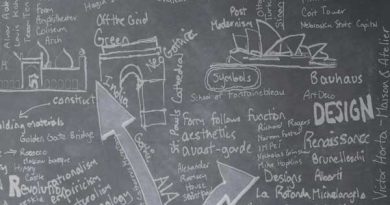What is the 8D Problem Solving? And How to use the 8D Report?
The 8D problem-solving process (also known as the 8 Disciplines) is very different from previous processes we explored previously, such as the Double Diamond process or the IBM Design Thinking. The 8D process works in a rigid standardised nature to address the crisis caused by problems. The 8D process aims to walk with the team to highlight the problem, its root causes and propose a long-term solution. The process is documented in an 8D report which includes details of each of the eight stages. At the end of this article, we will explore an example report, and you can find a free 8D report template to download.
In times of crisis, companies face the challenge of analysing and solving problems efficiently in a short time to save developed projects. Problem-solving techniques such as the TRIZ method and Hurson’s Production Thinking Model allow companies to overcome crises and solve problems using less effort and time.
Read also:
- Stage Gate Process: The Complete Practice Guide
- The Double Diamond Design Thinking Process and How to Use it
- A Guide to the SCAMPER Technique for Creative Thinking
- Design Thinking Tools: Reverse Brainstorming
Brief History of the 8D Problem Solving
The 8D method was first implemented by the US government during WW II as a military standard and was referred to as the Army Directive 1520, “Remedies and disposal of nonconforming materials.” In 1987, the demand for a team-oriented problem-solving method increased among the management organisation in the automotive industry to find a way to eliminate recurring issues.
Ford Motor Company published their manual, Team Oriented Problem Solving (TOPS), which includes their 8 Disciplines of the problem-solving process. The process was initially used to deal with quality control and safety issues inside the company but later expanded its role to a team approach problem-solving method. The 8D process is employed by engineers and designers to identify, analyse, and correct problems by eliminating the primary source that caused the problem.
So, what are the eight steps in the 8D methodology? The 8D problem solving process includes 8 Disciplines. In the mid-90s, a D0 step for planning was added to the process. The 8D steps include the following:
- D0: Plan
- D1: Team formation
- D2: Describe the problem
- D3: Develop a temporary containment plan
- D4: Determine and verify root causes
- D5: Verify the permanent solution
- D6: Implement the permanent solution
- D7: Prevent recurrence
- D8: Congratulate your team
The 8 Disciplines aim to achieve the following targets while solving the specified problem:
- Think as a team while solving the problem
- Isolate the situation and understand its causes
- Identify the factors that contribute to the problem
- Provide a temporary solution to halt the impact of the problem
- Eliminate the causes of the problem and the factors contributing to it
- Prevent the problem from recurring
When Should the 8D Problem Solving be Used?
Based on the above targets, the 8D problem solving process is designed for complex problems whose solution exceeds the ability of one expert. Also, it aims to establish communication for problem resolution through different levels inside the company. In some situations, the consumer or the management team requests the application of the 8D process through several forms or documentation.
While 8D problem solving is suitable for recurring problems that may repeatedly occur within a project or company, it is not ideal for simple issues that can be solved quickly by individual efforts. The process is unsuitable for a problem that can be solved with a straightforward solution. The 8D process is designed for complex issues, which require several weeks to solve and the involvement of at least four people.
8D problem solving provides a systematic process to find and solve problems. Therefore, if the situation requires choosing between alternative solutions, 8D acknowledges that other tools may help solve the problem better than the 8D process.
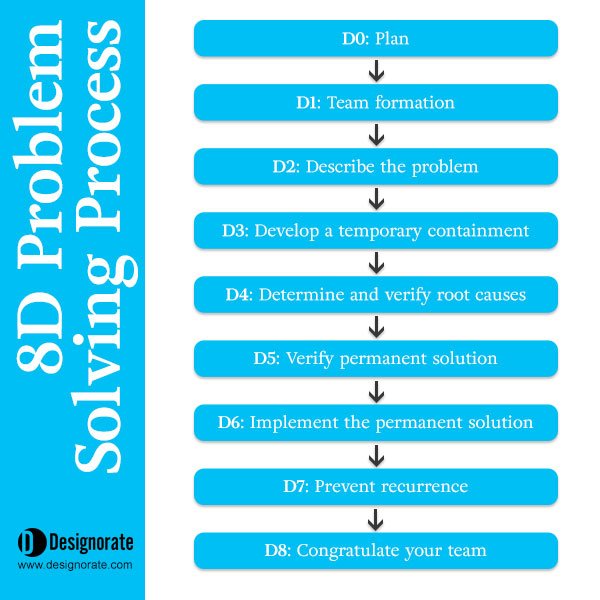
How to Apply the 8D Problem Solving Process?
The steps below form the 8 Discipline process to achieve targeted problem solving through the eight steps.
D0: Plan
This discipline is also known as the Pre 8D because it aims to understand the problem and determine if the 8D process is the correct method to use. At this stage, the team aims to answer general questions such as:
- Is this a new problem, or has it happened before?
- Is this a recurring problem?
- What is the history of this issue?
- What was the method used to solve the problem before?
At this stage, the target is to learn about the problem’s history and decide if the 8D process is the best tool to solve the problem.
D1: Team Formation
Thinking as a team can produce more efficient solutions than trying to solve a problem alone. The team includes all the stakeholders involved in the situation. The team communicates with each other and performs brainstorming to solve the problem (check Design Thinking Tools: Reverse Brainstorming). If the team does not know each other, the brainstorming time can be used to learn how to teach members to explore ideas together. Methods can be used in brainstorming sessions such as mind mapping, Six Thinking Hats, and Lego Serious Play.
D2: Describe the Problem
After team formation, the second step is to understand the problem and its risks. This stage starts with a risk analysis to identify the situation and how it can affect the project flow. Several methods can be used to analyse the problem from different perspectives, including SWOT analysis, SCAMPER technique, and similar tools. This stage is essential to building a clear vision of the problem and ensuring all stakeholders have the same understanding of the situation.
D3: Develop a Temporary Containment Plan
While solving the problem, there should be a temporary containment plan to prevent the problem from affecting the rest of the project or the final product. This temporary containment solution is a short-term operation such as adding more labour, increasing the quality measurements, applying a risk plan, etc.
It is essential to understand that the containment action is not the real solution and can only be used for the short term. Therefore, this action can be applied internally and not affect the process of reaching a permanent solution.
D4: Determine and Verify Root Causes
This stage aims to investigate the root causes of the problem; it can be considered the core of the 8D problem solving process. In many problems, what we see as causes are symptoms of other root causes. This misunderstanding can lead to inaccurate attempts at solutions that can have negative consequences in the future and leave the underlying problem unsolved.
An intensive investigation should be implemented because, in many cases, the root cause is hidden inside the process and covered by many symptoms, which is confusing. Some tools can be used to define the root causes of the problem, such as brainstorming, statistical analysis, flow charts, audits, etc.
D5: Verify the Permanent Solution
Once the root cause is defined, the solution becomes apparent, and the team better understands how to solve the problem. However, the symptoms and other related factors may create difficulties deciding how best to apply the solution. So, these other factors should be considered when determining the permanent solution to the dilemma.
When choosing the permanent solution to the problem, it should meet the following criteria to ensure it is the ideal solution for the problem:
- The solution should be practical
- The solution should be feasible
- The solution should be cost-effective
- The solution should not fail during production
- The solution should be implemented in all affected facilities in the company
D6: Implement the Permanent Solution
Once the solution is approved, this step tends to work as an action plan. This plan aims to outline the steps to implement the solution. It is common to ask questions in this stage: What should be done? Who should be involved in the correction plan?
More documentation and detailed plans should be created if the solution is complex and needs further procedures. The method may include training the team and checking the plan’s progress for further development and improvement.
D7: Prevent Recurrence
Once the action plan is set and ready to be implemented, the team should establish a plan to prevent the problem from occurring in the future. The action plan should be tested and documented as part of the process to avoid the recurrence of the problem. Some of the tools that can achieve this goal are Control Charts, Capabilities Analysis, and Control Plans.
D8: Congratulate the Team
After completing the task and implementing the solution, the team deserves an acknowledgement of their work and a celebration. This event will positively impact the stakeholders and reflect recognition of employees’ efforts from the management inside the company.
How do you Write an 8D Report?
The primary documentation used in the problem solving process is the 8D report. Korenko et al. (2013) presented an example of the 8D problem-solving application, Application 8D Method For Problems Solving. After this example, you can find a free 8D Report template that you can download and use for both commercial and noncommercial applications. The first part of the report, D0, includes information about the problem and the project details related to the project. D1 section contains details of the team involved in the project, roles, titles and contact information. D2 part of the report includes a detailed description of the problem and possible visual images to show the problem clearly. The report can consist of the type of damage of the failure and the function where the problem occurs (Figure 2).
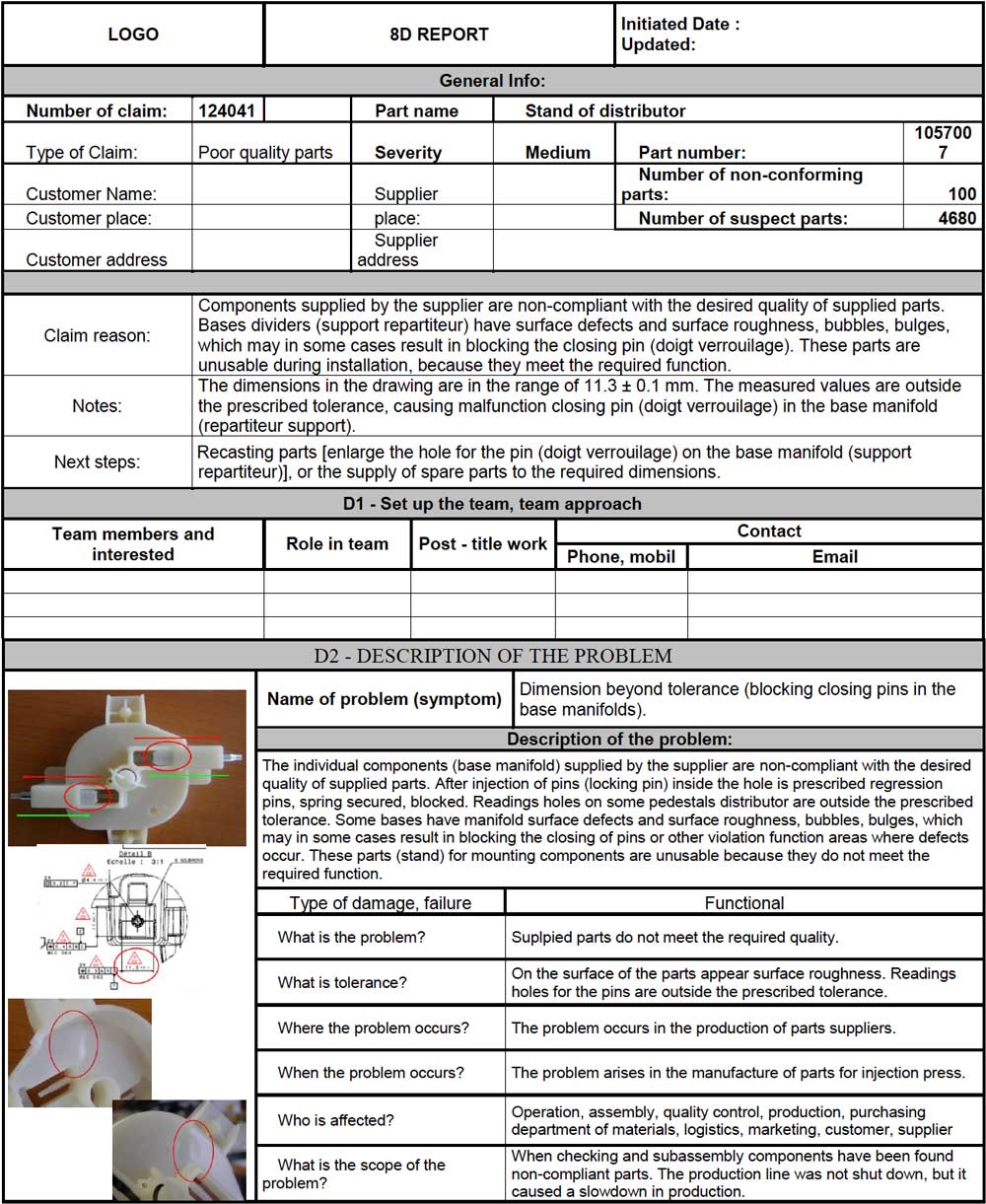
D3 includes details of the temporary solution for the problem required to stop the damage rapidly. In this part, the temporary remedy is described, particularly the symptoms affect, the responsibility, and the validation of the action. In D4, the team uses a root-cause method such as the 5WHYs or the Cause-Effect analysis (Fish Bone method). These methods help the team to identify the root causes of the problem. In Figure 3, the 5WHYs method is used several times to identify the root cause of the problem.
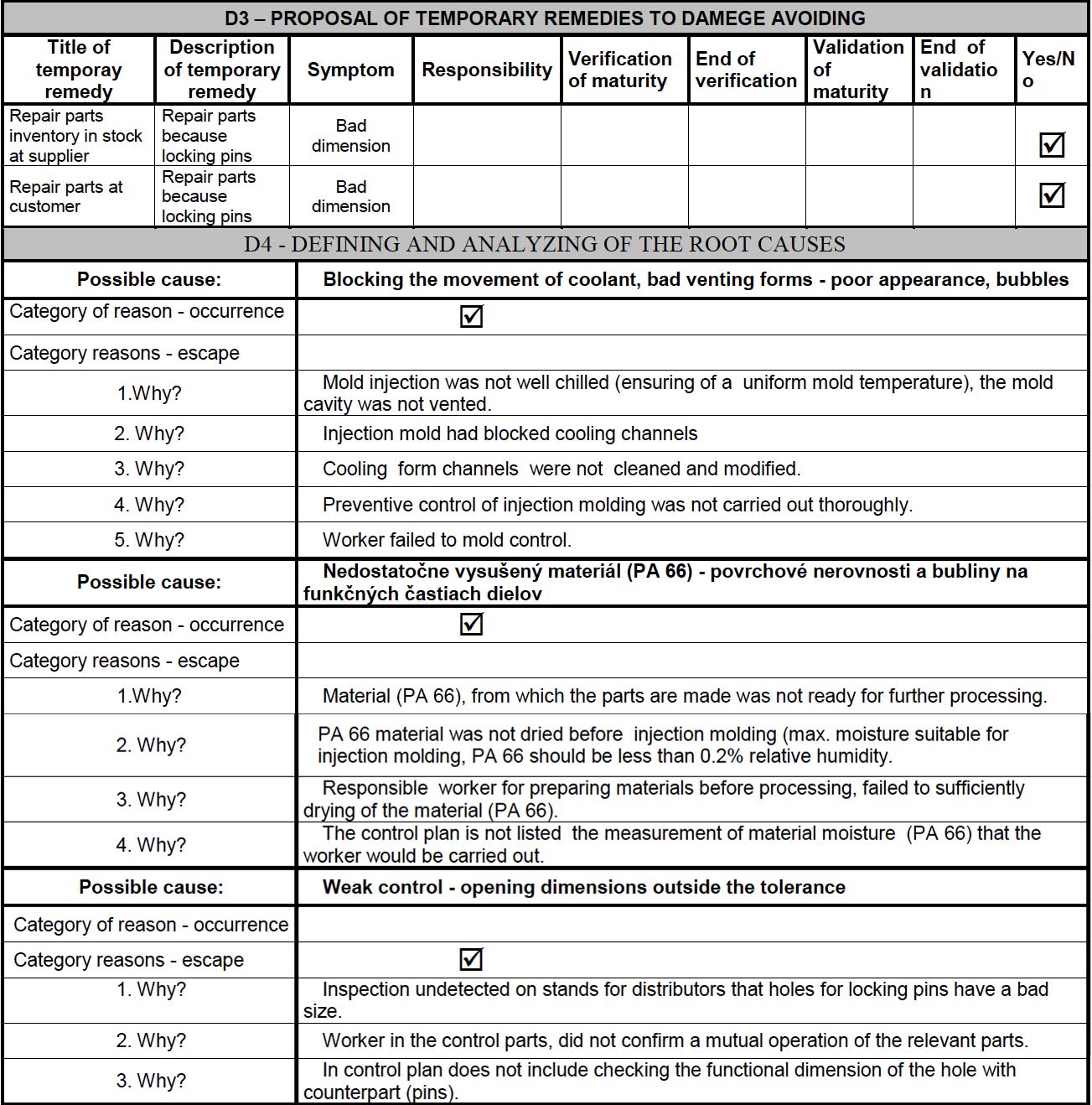
D5 of the report provides details about the permanent solution to fix the problem. Unlike the temporary solution, this aims to element the root causes of the problem. This section includes the procedure’s name, the reason to use it, the responsibility, the management approval to apply it and the expected date of completing the utilisation of the solution, as seen in Figure 4. In the following stage, D6, the team provides details on the implementation and validation of the permanent action.
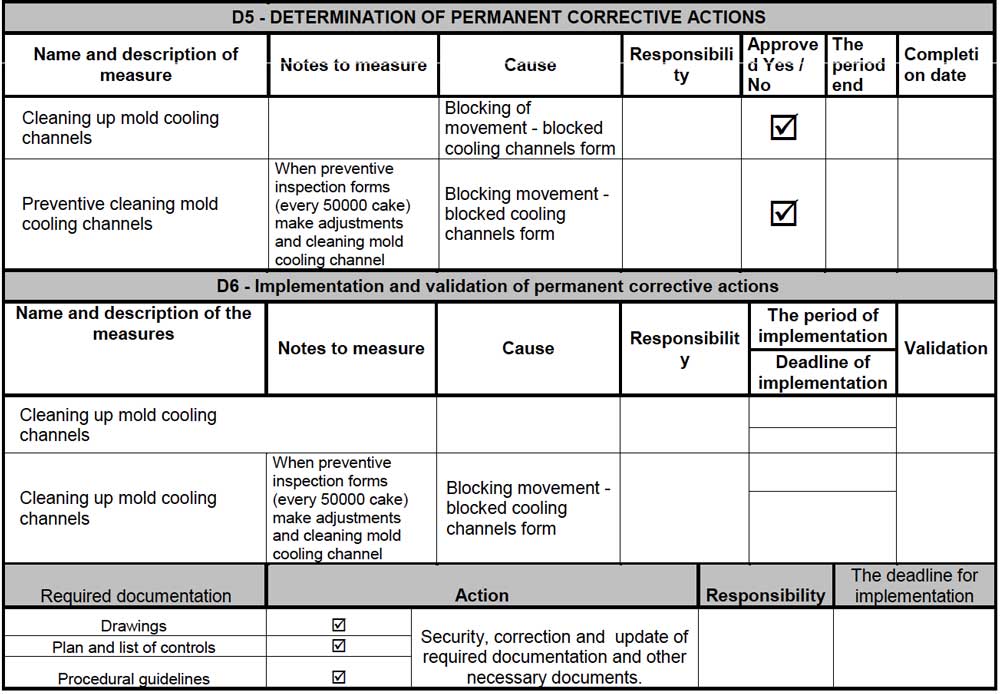
D7 provides details about preventing the recurrent problem, such as the name of the action after the validation process in the previous stage. Also, this stage provides details of the cause behind this action and elements about its responsibility and implementing details. Finally, in D8, the report includes a summary of the procedure and the proper approvals related to the procedure implementation (Figure 5).
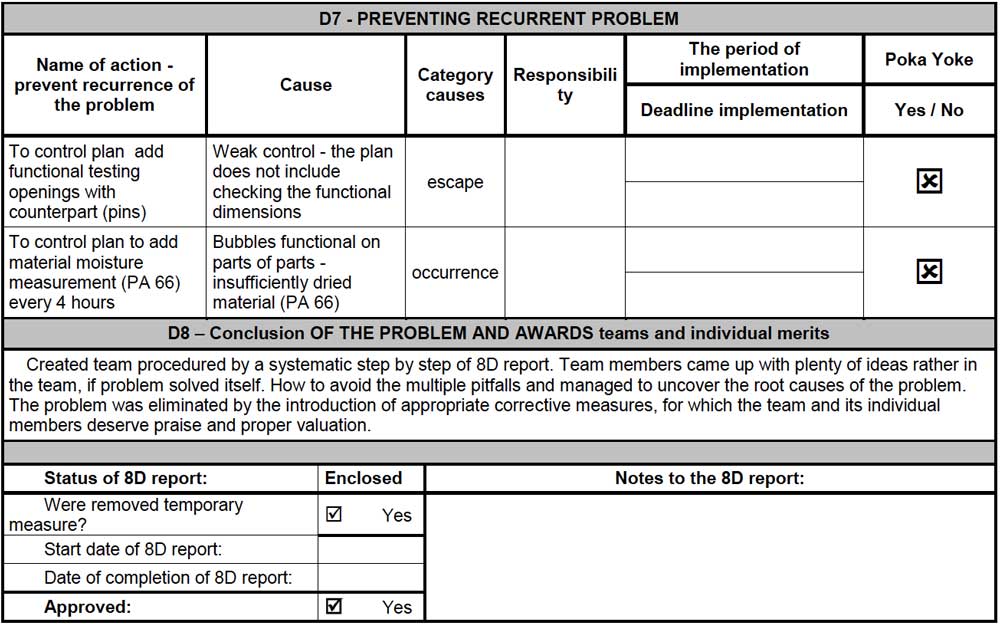
Free 8D Report Template Download

You can download the below 8D report, which you can use for commercial and noncommercial projects. Don’t forget to mention Designorate as the source of this free 8D report.
Download
Conclusion
The 8D Problem Solving process provides a reliable and systematic method that ensures that the problems inside a company or project are solved by eliminating their root causes and preventing recurrence. However, it is most suitable for complex problems that can take weeks or even months to solve. Therefore, the first stage aims to determine if the 8D process is ideal for the problem or if more straightforward tools should be implemented. If the 8D problem solving method is appropriate for your business problem, you have a step-by-step template to guide you through your attempts to find a suitable solution to the obstacle you need to overcome.
Bibliography
George, A., Ranjha, S., & Kulkarni, A. (2021). Enhanced problem solving through redefined 8D step completion criteria. Quality Engineering, 33(4), 695-711.
Kaplík, P., Prístavka, M., Bujna, M., & Viderňan, J. (2013). Use of 8D method to solve problems. In Advanced Materials Research (Vol. 801, pp. 95-101). Trans Tech Publications Ltd.
Korenko, M., Krocko, V., Zitnak, M., Foldesiova, D., Adamik, M., Allo, S., & Kuzenko, L. (2013). Application 8D method for problems solving. Вісник Львівського національного аграрного університету. Агроінженерні дослідження, (17), 330-339.
Zarghami, A., & Benbow, D. (2017). Introduction to 8D problem solving. The Journal for Quality and Participation, 40(3), 23-28.
Note: This post was originally published on 07/28/2015 10:54 am
Summary
The 8D Problem Solving (also known as Eight Disciplines) is used to solve a complex problem using eight steps. It is a team-oriented method. The 8D approach is based on solving the problem through short-term (temporary) saluting to reduce or stop the negative impact of the situation while the team is looking for the problem’s root cause to find a permanent solution.
The 8D report is a document that is used to record the 8D process including details related to the implementation of the solutions and evaluating these solution validity.
D1 – Set Up The Team, Team Approach
D2 – Description Of The Problem
D3 – Proposal Of Temporary Remedies To Damege Avoiding
D4 – Defining And Analyzing Of The Root Causes (5Whys)
D5 – Determination Of Permanent Corrective Actions
D6 – Implementation And Validation Of Permanent Corrective Actions
D7 – Preventing Recurrent Problem
D8 – Conclusion Of The Problem And Awards Teams And Individual Merits



